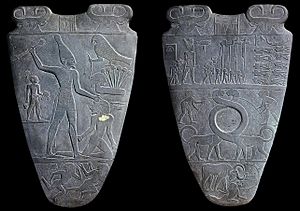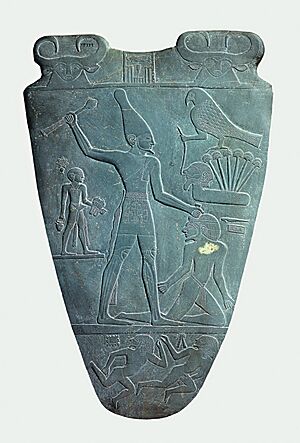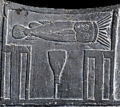Narmer Palette facts for kids
Quick facts for kids Narmer Palette |
|
|---|---|

Both sides of the Narmer Palette
|
|
| Material | Siltstone |
| Size | c. 64 cm × 42 cm |
| Created | 3200–3000 BC (circa) |
| Discovered | 1897–1898 Hierakonpolis |
| Discovered by | James Quibell Frederick W. Green |
| Present location | Egyptian Museum, Cairo |
| Identification | CG 14716 |
The Narmer Palette is a very old and important stone tablet from Ancient Egypt. It was made around 3100 BC. This makes it over 5,000 years old! It is famous because it has some of the first hieroglyphic writing ever found.
Many people think the Narmer Palette shows a big event: the joining of Upper (southern) and Lower Egypt (northern) into one country. This happened under a king named Narmer. The palette also shows King Narmer wearing two different crowns. On one side, he wears the White Crown of Upper Egypt. On the other side, he wears the Red Crown of Lower Egypt. This is the first time we see an Egyptian king wearing both crowns.
The Narmer Palette also shows many classic styles of Ancient Egyptian art. These art rules were already well-known when the palette was made. Some experts, like Bob Brier and A. Hoyt Hobbs, call it "The oldest Egyptian historical record."
Contents
Discovering the Ancient Palette
This amazing palette has stayed in almost perfect condition for five thousand years. It was found by two British archeologists, James E. Quibell and Frederick W. Green. They found it during their dig in 1897–98.
They were digging at a place called Nekhen, also known as Hierakonpolis. This was an important religious center for the god Horus. The palette was found in what they called the "Main Deposit" in the Temple of Horus. Other important items, like the Narmer Macehead, were also found there.
Even though palettes were usually used to grind makeup, the Narmer Palette is too big and heavy for personal use. It was probably a special object used in the temple. Maybe it was used to grind cosmetics to decorate statues of the gods.
Today, the Narmer Palette is a permanent part of the collection at the Egyptian Museum in Cairo. It is one of the first things visitors see when they enter the museum.
What the Narmer Palette Looks Like
The Narmer Palette is a shield-shaped tablet. It is about 63-centimetre-tall (25 in) and 42-centimetre-wide (17 in). It was carved from a single piece of dark gray-green stone called greywacke. This stone is very strong and does not flake easily. It came from a quarry that has been used since ancient times.
The pictures on the palette are carved in low relief. This means they don't stick out very far from the surface. At the top of both sides, there is a special royal symbol called a serekh. This symbol represents the king and the state. Inside the serekh, you can see symbols that sound like "n'r" (catfish) and "mr" (chisel). Together, these make the name Narmer.
On both sides, the serekhs are next to two heads of a cow goddess. These heads have curved horns and are thought to represent the goddess Bat. She was an important goddess in ancient Egypt.
The Front Side (Recto)
On the front side, you can see the two cow goddess heads at the top, just like on the back. The biggest picture on this side shows King Narmer. He is holding a royal mace in one hand. With the other hand, he grabs a kneeling prisoner by the hair.
On this side, Narmer wears the White Crown of Upper Egypt. His body is shown in a special way that was common in Egyptian art. His feet, legs, and head are shown from the side. But his body and shoulders face the front. This was done to show as much information as possible about a person on a flat surface.
Narmer also wears a belt with four beaded tassels. These tassels have ornaments shaped like the head of the goddess Hathor. At the back of his belt, there is a long fringe that looks like a lion's tail.
To the left of the king, there is a man carrying the king's sandals. To the right, there is the kneeling prisoner. Above the prisoner, you can see a falcon, which represents the god Horus. The falcon is sitting on top of some papyrus flowers, which are a symbol of Lower Egypt. The falcon holds a rope connected to a man's head coming out of the papyrus flowers.
The Back Side (Verso)
Below the cow goddess heads on the back side, there is a procession. King Narmer is much larger than everyone else in this scene. This artistic rule, called "hierarchical scale," shows that he is the most important person. On this side, he wears the Red Crown of Lower Egypt. He holds a mace and a flail, which are symbols of kingship.
Behind Narmer is his sandal-bearer. In front of the king, there is a man with long hair. Before this man, there are four standard bearers. They are holding up an animal skin, a dog, and two falcons.
Below the procession, two men are holding ropes tied to two strange creatures. These creatures are called serpopards. They are mythical animals that are a mix of a serpent and a leopard. Their long, twisting necks form a circle in the middle of the palette. This circle is where cosmetics would have been ground. The intertwined necks might represent the joining of Upper and Lower Egypt.
At the very bottom of the back side, you can see a bull. The bull is knocking down the walls of a city and stepping on a fallen enemy. This bull represents King Narmer himself. Bulls were often linked to Egyptian kings, showing their strength and power.
Why the Palette is Important
The Narmer Palette has caused a lot of discussion among experts. Some believe it shows a real historical event, like the unification of Egypt. Others think it was made to create a story or myth about the king's power over both Upper and Lower Egypt.
Scholars like Nicholas Millet suggest that the palette doesn't show one specific event. Instead, it might represent the important events of the year it was given to the temple. Others, like John Baines, believe its main purpose was to show that the king, with the help of the gods, controlled the world and defeated his enemies.
Images for kids
-
Serekhs showing Narmer's name (catfish and chisel symbols).
See also
- List of ancient Egyptian palettes
- Libyan Palette
- Warka Vase






